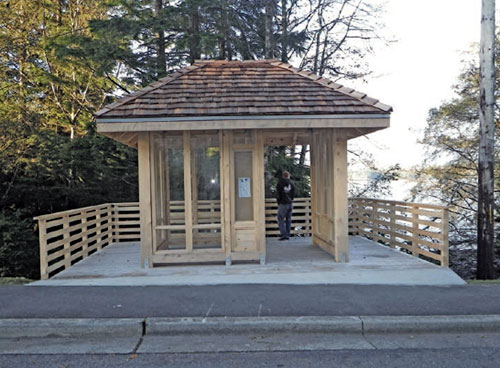
New report provides conservation, management strategies for yellow-cedar in Alaska
January 13, 2016
The report, A Climate Adaptation Strategy for Conservation and Management of Yellow-Cedar in Alaska, is the first to provide a comprehensive science-based approach for managing the species in the face of climate change in the state of Alaska, where some populations of the tree have been declining over the past century. The report was produced in collaboration with land managers and specialists with the Forest Service's Alaska Region and State and Private Forestry forest health professionals and will be an important reference for the U.S. Fish and Wildlife Service to review as it considers a petition to list yellow-cedar under the Endangered Species Act.
Bus stop shelter in Ketchikan, Alaska made from yellow-cedar.
Yellow-cedar is a culturally, economically, and ecologically valuable species that grows as far north as Prince William Sound in Alaska to as far south as the northern tip of California. Some yellow-cedar populations in Alaska and British Columbia have experienced mortality over the past 100 years linked to a warming climate, Hennon and his colleagues discovered in previous work. Loss of snow cover exposes yellow-cedar's roots to freezing, which can kill the tree. The new technical report is divided into four sections that provide an exhaustive review of nearly every aspect of yellow-cedar in Alaska:
"Land managers can use our report to develop active management approaches, such as salvage harvesting of dead cedar or augmenting other tree species, in decline-affected forests, and to enhance yellow-cedar in suitable areas by planting seedlings and favoring yellow-cedar during thinnings," Hennon said. "Our report also can serve as a scientific foundation for developing adaptation strategies in other forests affected by climate change." Hennon and his colleagues are now working with a team of U.S. and Canadian scientists to conduct a vulnerability assessment of yellow-cedar across its entire range, from Alaska to California. The Pacific Northwest Research Station is headquartered in Portland, Oregon.
On the Web:
Edited by Mary Kauffman, SitNews
Source of News:
|
||
